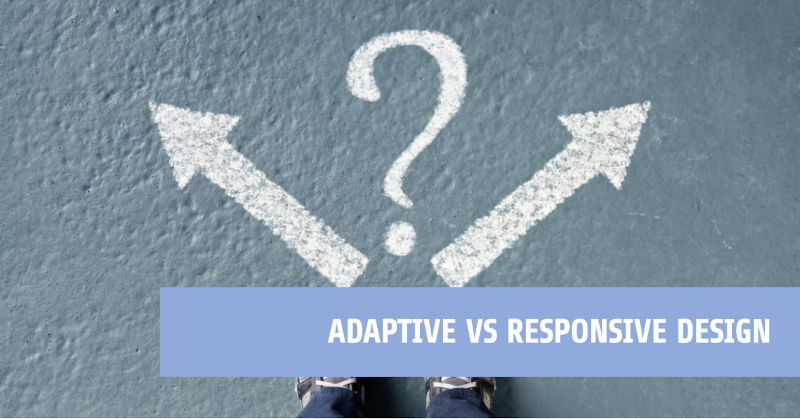In web design, the choice between adaptive vs responsive design approaches can significantly impact your website’s performance and user experience. Understanding the key distinctions between these two methods is essential when crafting a digital presence that resonates with your audience. In this article, we’ll delve into the nuances of adaptive vs. responsive design, empowering you to make informed decisions about your website’s design strategy.
Table of Content
Understanding Adaptive vs Responsive Design

Responsive design is a versatile approach to web development that ensures your website looks and functions well on all types of devices, from desktop computers to smartphones and tablets. The key concept behind responsive design is adaptability. Here’s how it works:
- Fluid Grid System: In responsive design, a fluid grid system is used to structure the layout. Instead of fixed pixel values, percentages are used to define the width of elements. This allows content to automatically adjust to the screen size it’s viewed on.
- CSS Media Queries: Responsive design employs CSS media queries to detect the screen size and apply appropriate styling rules. For example, if a user accesses your site on a small smartphone screen, the media queries will trigger a layout with larger fonts, resized images, and restructured navigation to ensure a user-friendly experience.
- Flexible Images: Images in responsive design are made flexible. They can scale up or down based on the available screen space without losing quality or breaking the layout.
- Viewport Meta Tag: The viewport meta tag is used to control how a webpage is displayed on a mobile device. It helps in setting the initial zoom level and scaling of the page.
Responsive design offers numerous benefits, including better user experience, improved SEO, and the ability to reach a broader audience. It eliminates the need for creating separate mobile versions of your website, saving time and resources. In a world where users access websites from a variety of devices, responsive design has become a fundamental aspect of modern web development.
Pros and Cons of Responsive Design
Responsive design offers many advantages, but it’s essential to consider both its strengths and weaknesses when deciding if it’s the right choice for your website.
Pros:
- Improved User Experience: Responsive design ensures a consistent and user-friendly experience across all devices. Visitors can access your content seamlessly, which can lead to higher engagement and conversions.
- Better SEO: Google prefers mobile-friendly websites, and responsive design aligns with Google’s recommendations. This can result in better search engine rankings and increased visibility.
- Cost-Efficient: Developing and maintaining a single responsive website is more cost-effective than creating multiple versions for different devices. It saves both time and resources.
- Easier Maintenance: With a responsive design, you only need to update one website. Changes automatically adapt to various screen sizes, reducing the risk of errors and inconsistencies.
Cons:
- Complexity: Designing a responsive website can be more complex and time-consuming than traditional designs, particularly for intricate layouts.
- Performance Optimization: Ensuring fast loading times on all devices can be challenging. Images and other elements may need optimization to maintain performance.
- Content Prioritization: Responsive designs require careful consideration of content prioritization. You must decide which elements are most important for smaller screens, potentially leading to compromises.
- Load Times on Mobile: Responsive sites can still have slower load times on mobile networks. Efforts are needed to optimize performance further.
Responsive design is a valuable approach for creating a mobile-friendly website, offering a consistent user experience and SEO benefits. However, it may require more initial effort and ongoing maintenance to ensure optimal performance. Weigh the pros and cons carefully to determine if responsive design aligns with your specific project goals.
Exploring Adaptive Design
Adaptive design is an approach that tailors your website to specific device categories or screen sizes. Instead of a single flexible layout, adaptive design creates multiple layouts, each optimized for a particular type of device. Here’s a closer look:
- Predefined Layouts: In adaptive design, developers create distinct layouts for different device categories, such as smartphones, tablets, and desktops. These layouts are predefined and finely tuned for each screen size.
- Server-Side Detection: Adaptive designs often use server-side detection to identify the user’s device. Based on this detection, the server serves the appropriate layout. This ensures that users get a layout tailored to their device’s capabilities.
- Enhanced Control: Adaptive design offers precise control over the user experience. You can optimize layouts, navigation, and content to suit each device category, delivering a more tailored and efficient experience.
Adaptive design is a powerful approach when a tailored user experience is essential for specific device categories. It excels in scenarios where precise control over layouts and performance optimization are paramount. However, it requires careful planning and may involve more development effort compared to responsive design.
For further insights into adaptive design, you can explore the article in inVision titled “Adaptive Design.”
When to Use Responsive Design
Responsive design is an excellent choice for various web development scenarios, offering flexibility and adaptability to a wide range of projects. Here’s when you should consider using responsive design:
- Budget Constraints: If you have budget limitations and need to create a single website that caters to both desktop and mobile users, responsive design is cost-effective. It eliminates the need to build and maintain separate versions of your site.
- Content Consistency: When you want to maintain consistent branding, content, and features across all devices, responsive design is ideal. It ensures a unified user experience, reinforcing your brand identity.
- SEO Benefits: Search engines like Google prioritize mobile-friendly websites in their rankings. Choosing a responsive design can improve your SEO efforts, leading to better visibility and traffic.
- Content Focus: If your website’s content remains consistent across devices, responsive design is a solid choice. It adapts your existing content to different screen sizes while keeping your message intact.
- Ease of Maintenance: Responsive sites are easier to maintain since updates and changes apply universally. This streamlines the maintenance process and minimizes the risk of inconsistencies.
- Time Efficiency: When time is a critical factor, responsive design accelerates development. You don’t need to spend extra time creating separate layouts for various devices.
- Accessibility: Responsive design inherently addresses accessibility concerns by ensuring content is accessible across devices.
Pros of When to Use Responsive Design:
- Cost-Efficiency: Responsive design is budget-friendly because it involves creating and maintaining a single website. There’s no need to develop separate versions for various devices, saving time and resources.
- Consistent User Experience: Responsive design ensures a consistent user experience across all devices. Visitors can access your content seamlessly, which can lead to higher engagement and conversions.
- Improved SEO: Search engines like Google prioritize mobile-friendly websites. By choosing responsive design, you align with Google’s recommendations, potentially leading to better search engine rankings and increased visibility.
- Ease of Maintenance: With responsive design, you only need to update one website. Changes automatically adapt to different screen sizes, reducing the risk of errors and inconsistencies.
- Time Efficiency: Responsive design accelerates development. You don’t need to spend extra time creating separate layouts for various devices.
- Accessibility: Responsive design inherently addresses accessibility concerns by ensuring content is accessible across devices.
Cons of When to Use Responsive Design:
- Complexity for Intricate Layouts: Responsive design may face complexity issues with intricate layouts. In such cases, achieving responsiveness can be challenging.
- Performance Optimization: Ensuring fast loading times on all devices can be challenging. Images and other elements may require optimization to maintain performance.
- Content Prioritization: Responsive design requires careful consideration of content prioritization. You must decide which elements are most important for smaller screens, potentially leading to compromises.
- Load Times on Mobile: Responsive sites can still have slower load times on mobile networks. Efforts are needed to optimize performance further.
Responsive design is suitable for projects with budget constraints, a need for content consistency, SEO priorities, streamlined maintenance, tight schedules, and accessibility requirements. Understanding your project’s specific goals and audience will help you determine if responsive design is the right choice.
When to Use Adaptive Design
Adaptive design shines in specific situations where tailored user experiences are paramount. Consider using adaptive design when:
- Device-Specific Needs: Your project requires unique layouts, functionalities, or content for distinct device categories. For example, an e-commerce site may want to emphasize product images on tablets while providing a simplified mobile checkout process.
- Performance Optimization: Performance is critical, and you need to deliver fast loading times on specific devices. Adaptive design allows you to optimize layouts and content for the best performance on each device.
- Resource Availability: If you have the resources to invest in creating and maintaining multiple layouts, adaptive design offers precise control over each version. This is beneficial when you want to maximize the user experience.
- Complex Navigation: Complex navigation structures may benefit from adaptive design. You can simplify navigation for mobile users and provide more extensive menus for desktop users.
- Device-Specific Features: When you want to leverage unique features of certain devices, such as GPS or touch gestures, adaptive design enables you to tailor experiences accordingly.
- Diverse Audiences: If your audience varies greatly in device preferences, adaptive design allows you to cater to their specific needs.
Pros of Adaptive Design:
- Precise Control: You have granular control over layouts, allowing for a highly customized user experience.
- Performance Optimization: By delivering optimized layouts, adaptive design can lead to faster loading times on specific devices.
- Device-Specific Features: You can take advantage of unique features on certain devices, enhancing the user experience further.
Cons of Adaptive Design:
- Development Complexity: Creating and maintaining multiple layouts can be time-consuming and resource-intensive.
- Increased Maintenance: Updates and changes must be applied to each layout individually, potentially increasing maintenance efforts.
External Link: To delve deeper into adaptive design, explore this informative article on Smashing Magazine titled “Adaptive Design: What It Is and How to Use It.”
Combining Both Approaches
In some cases, the best web design strategy isn’t purely responsive or adaptive—it’s a blend of both. Combining these approaches allows you to harness the strengths of each and create a versatile and optimized user experience.
Here’s how you can effectively merge responsive and adaptive design elements:
- Responsive Base: Start with a responsive foundation. This ensures that your website is mobile-friendly and capable of adapting to various screen sizes through CSS media queries.
- Device Detection: Implement device detection mechanisms within your responsive design. Server-side or client-side detection can identify the user’s device category or capabilities.
- Adaptive Enhancements: Based on device detection, apply adaptive enhancements. These modifications may include loading specific stylesheets, scripts, or content to further tailor the experience. For instance, you might prioritize loading high-resolution images for devices with larger screens.
- Feature Utilization: Leverage device-specific features when relevant. For example, if a user accesses your site from a smartphone with GPS capabilities, offer location-based services.
- Testing and Optimization: Rigorous testing is crucial to ensure that the combined approach works seamlessly. Regularly analyze user feedback and behavior to make refinements.
- Content Prioritization: Maintain consistent content prioritization principles from responsive design. Ensure that essential content remains accessible on all devices.
By merging responsive and adaptive design, you create a flexible and finely tuned web experience. Users benefit from consistent access to your content while enjoying device-specific enhancements when available. This approach can be particularly useful for websites catering to diverse audiences and device types.
When considering this approach, carefully plan and execute it to strike the right balance between responsive flexibility and adaptive precision.
The Future of Web Design
The field of web design is in a constant state of evolution, driven by technological advancements and changing user expectations. Here’s a glimpse into what the future holds for web design:
- AI-Powered Design: Artificial Intelligence (AI) is increasingly being used to automate design tasks. AI-driven tools can analyze user data and preferences to create personalized, dynamic web experiences.
- Voice User Interface (VUI): With the rise of voice-activated devices like smart speakers and voice assistants, VUI design is gaining importance. Websites will need to accommodate voice search and interaction.
- Augmented Reality (AR) and Virtual Reality (VR): AR and VR technologies are set to transform web design by creating immersive, interactive experiences. Websites may incorporate AR/VR elements for product demonstrations, virtual tours, and more.
- Minimalist and Sustainable Design: Simplicity and sustainability will continue to be design trends. Minimalist, eco-friendly designs that prioritize speed and accessibility will gain prominence.
- Microinteractions: These small, subtle animations or design elements enhance user engagement. They will become more common for providing feedback and improving user experience.
- Mobile-First Continues: As mobile device usage grows, mobile-first design principles will remain vital. Designers will focus on delivering fast, user-friendly mobile experiences.
- Dark Mode: Dark mode, known for reducing eye strain and saving battery life, will become a standard design option.
- Progressive Web Apps (PWAs): PWAs combine the best of web and mobile apps. They offer fast loading times, offline capabilities, and enhanced user experiences.
- Accessibility Focus: Inclusivity will remain a priority, with designers making efforts to ensure websites are accessible to all, regardless of disabilities.
- Data Privacy: With increasing concern about data privacy, web design will incorporate features that protect user information and build trust.
The future of web design is exciting and dynamic, marked by innovation and a relentless pursuit of improved user experiences. To stay relevant, designers will need to adapt to emerging technologies and trends while keeping accessibility, user privacy, and sustainability at the forefront.
Conclusion
In conclusion, the choice between adaptive and responsive design depends on your project’s specific goals and requirements. Here’s a quick recap:
Key Differences:
- Responsive Design offers flexibility, cost-efficiency, and easier maintenance, making it suitable for content-focused websites.
- Adaptive Design provides precise control, performance optimization, and device-specific features but may require more development effort.
Guidance:
- Consider Responsive Design for a consistent user experience across devices, budget constraints, and streamlined maintenance.
- Opt for Adaptive Design when you need precise control, and performance optimization, and can allocate additional resources.
- In some cases, a hybrid approach combining elements of both can offer a versatile and optimized user experience.
Stay Updated:
Web design continually evolves. To stay ahead:
- Keep an eye on emerging trends like AI-powered design, voice interfaces, and augmented reality.
- Prioritize user experience, accessibility, and data privacy.
- Explore industry resources and engage with the web design community to remain up-to-date with evolving practices.
By making informed design decisions and adapting to new developments, you’ll be well-prepared to create websites that excel in our ever-changing digital landscape.




